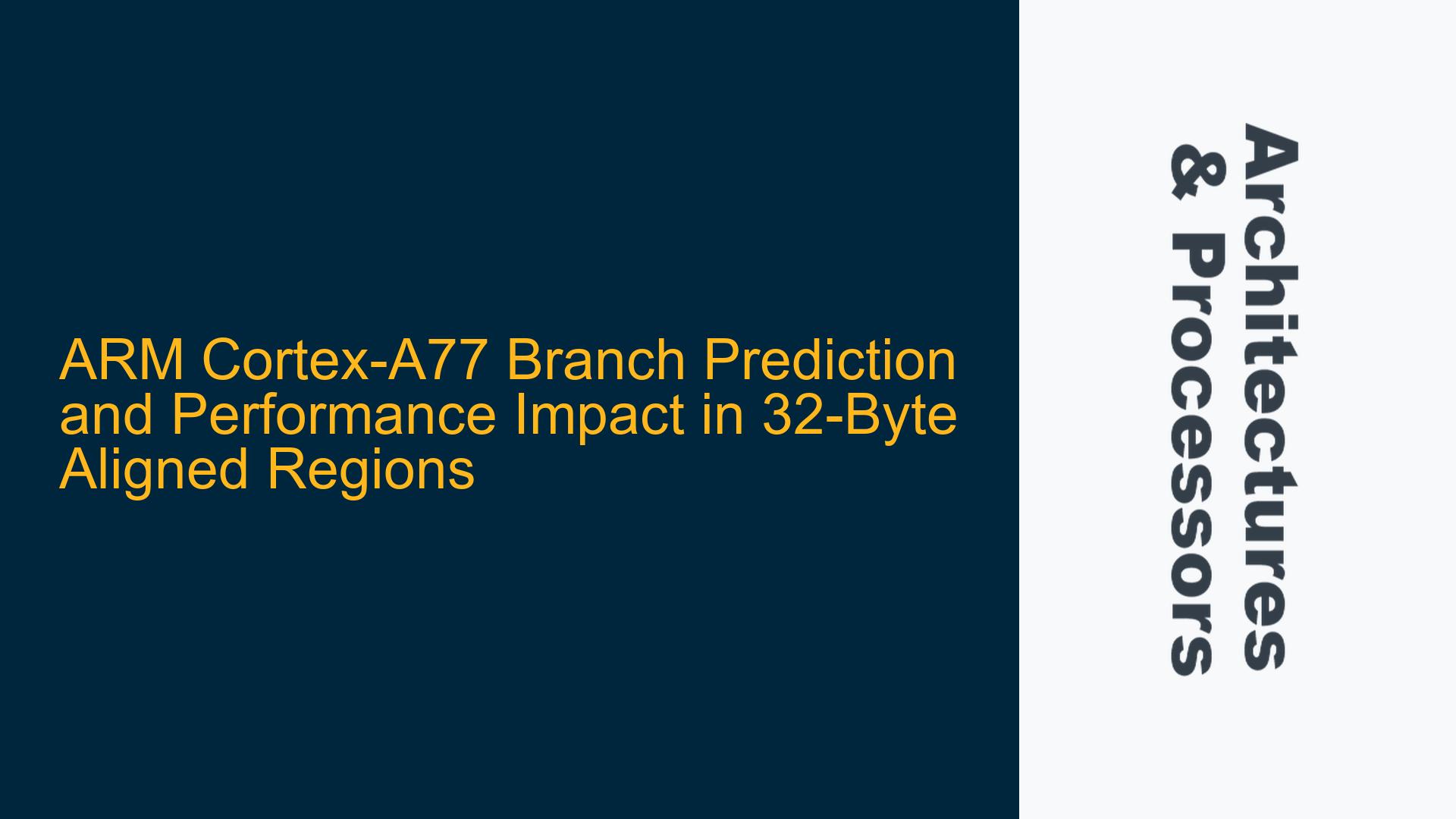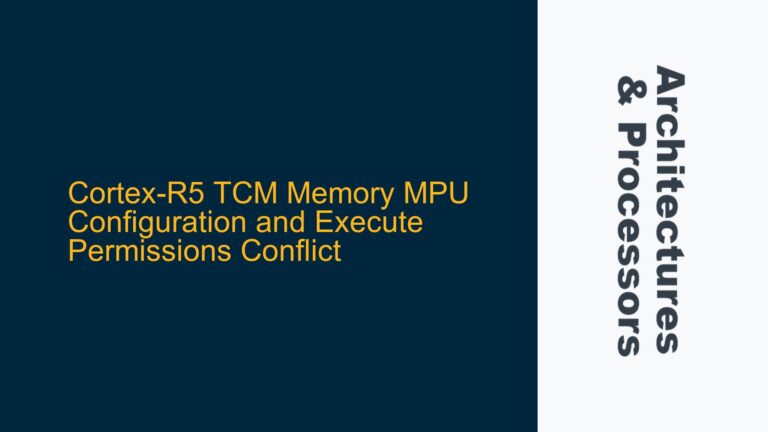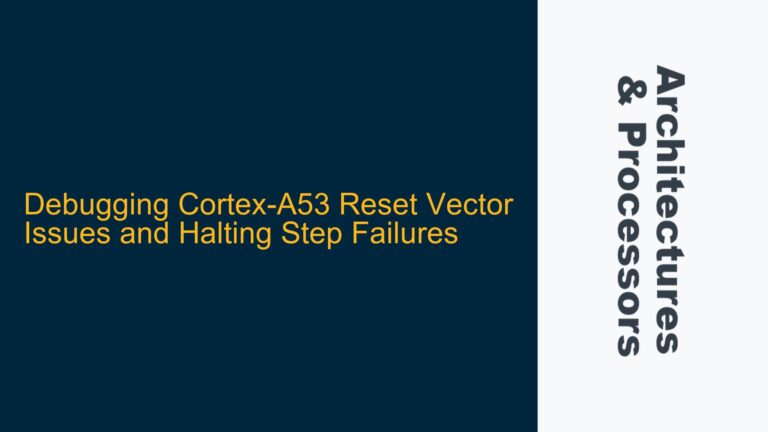ARM Cortex-A77 Branch Prediction Challenges in 32-Byte Aligned Instruction Memory
The ARM Cortex-A77 is a high-performance processor core designed for advanced applications, leveraging sophisticated branch prediction mechanisms to maximize instruction throughput. However, the performance of the Cortex-A77 can be significantly influenced by the placement and behavior of branch instructions within 32-byte aligned memory regions. This alignment is critical because the Cortex-A77 fetches instructions in 32-byte chunks, and the branch prediction unit (BPU) operates on these chunks to predict the flow of execution. When multiple branch instructions are present within a single 32-byte region, the interdependencies between their predictions can create complexities that degrade performance.
The Cortex-A77 employs a dynamic branch predictor that uses a combination of global and local history to predict the direction of branches. This predictor is highly effective for single branches but can struggle when multiple branches are densely packed within a 32-byte region. The challenge arises because the outcome of earlier branches within the same region can influence the prediction accuracy of subsequent branches. For example, if a branch instruction early in the 32-byte region is mispredicted, the processor may fetch and decode subsequent instructions incorrectly, leading to pipeline stalls and wasted cycles.
Furthermore, the Cortex-A77’s instruction fetch unit (IFU) and BPU are optimized for sequential execution. When multiple branches are present in close proximity, the IFU may fetch instructions that are never executed due to mispredictions, reducing the effective fetch bandwidth. This issue is exacerbated in loops or frequently executed code paths where branch density is high. The Cortex-A77’s ability to handle such scenarios is a testament to its advanced microarchitecture, but developers must still be mindful of branch placement to avoid performance bottlenecks.
Interdependencies Between Branch Directions and Prediction Accuracy
The primary cause of performance degradation in the Cortex-A77 when dealing with multiple branches in a 32-byte aligned region is the interdependency between branch directions and prediction accuracy. The Cortex-A77’s BPU relies on historical data and pattern recognition to predict branch outcomes. However, when multiple branches are present in close proximity, the predictor may struggle to maintain accurate predictions due to the following reasons:
First, the global history register (GHR) used by the BPU tracks the outcomes of recent branches to inform future predictions. When multiple branches are executed in quick succession, the GHR may not have enough time to update accurately, leading to stale or incorrect predictions. This is particularly problematic in tight loops where branches are frequently taken or not taken in rapid succession.
Second, the local history table (LHT), which stores the history of individual branches, may also be affected by high branch density. The LHT relies on the assumption that each branch has a unique history that can be used to predict its future behavior. However, when multiple branches are packed into a small memory region, the LHT entries may overlap or conflict, reducing prediction accuracy. This is especially true for branches with similar patterns of behavior, as the LHT may struggle to distinguish between them.
Third, the Cortex-A77’s return stack buffer (RSB), used to predict return addresses for function calls, can also be impacted by high branch density. If multiple function calls and returns occur within a 32-byte region, the RSB may become overwhelmed, leading to incorrect return address predictions. This can cause the processor to fetch instructions from the wrong location, resulting in pipeline flushes and performance penalties.
Finally, the Cortex-A77’s instruction cache (I-cache) and instruction translation lookaside buffer (ITLB) can also be affected by high branch density. When multiple branches are present in a 32-byte region, the I-cache may evict useful instructions to make room for speculative fetches, reducing cache efficiency. Similarly, the ITLB may experience increased pressure due to frequent changes in the instruction stream, leading to higher latency for address translations.
Optimizing Branch Placement and Leveraging Cortex-A77’s Branch Prediction Features
To mitigate the performance impact of multiple branches in 32-byte aligned regions, developers can employ several strategies to optimize branch placement and leverage the Cortex-A77’s advanced branch prediction features. These strategies focus on reducing branch density, improving prediction accuracy, and minimizing pipeline stalls.
First, developers should aim to reduce the number of branches within a 32-byte region by restructuring code to minimize conditional jumps. This can be achieved by unrolling loops, inlining functions, and using predication to eliminate branches. For example, instead of using a series of conditional branches to handle different cases, developers can use conditional move instructions or logical operations to achieve the same result without branching.
Second, developers should ensure that branches are placed in a way that maximizes the effectiveness of the Cortex-A77’s BPU. This includes aligning branches to 32-byte boundaries to reduce the likelihood of multiple branches being present in the same fetch window. Additionally, developers should avoid placing branches with similar patterns of behavior in close proximity, as this can lead to conflicts in the LHT and reduced prediction accuracy.
Third, developers can use the Cortex-A77’s branch target buffer (BTB) and indirect branch predictor (IBP) to improve prediction accuracy for indirect branches. The BTB stores the target addresses of recently executed branches, while the IBP uses a combination of global and local history to predict the targets of indirect branches. By ensuring that indirect branches are placed in a way that maximizes BTB and IBP effectiveness, developers can reduce the likelihood of mispredictions and pipeline stalls.
Fourth, developers should leverage the Cortex-A77’s return stack buffer (RSB) to improve prediction accuracy for function returns. This can be achieved by minimizing the number of nested function calls and ensuring that return addresses are predictable. Additionally, developers can use the Cortex-A77’s call and return instructions to explicitly manage the RSB, reducing the likelihood of incorrect return address predictions.
Finally, developers should optimize the use of the Cortex-A77’s instruction cache (I-cache) and instruction translation lookaside buffer (ITLB) to reduce latency and improve fetch efficiency. This includes aligning code to cache line boundaries, minimizing the size of frequently executed code paths, and using prefetching to reduce cache misses. Additionally, developers should ensure that the ITLB is not overwhelmed by frequent changes in the instruction stream by minimizing the number of page transitions and using large pages where possible.
By following these strategies, developers can optimize the performance of the Cortex-A77 when dealing with multiple branches in 32-byte aligned regions. These optimizations not only improve branch prediction accuracy but also reduce pipeline stalls and maximize instruction throughput, leading to better overall performance.
Conclusion
The ARM Cortex-A77 is a highly advanced processor core that relies on sophisticated branch prediction mechanisms to achieve high performance. However, the placement and behavior of branch instructions within 32-byte aligned memory regions can significantly impact performance due to the interdependencies between branch directions and prediction accuracy. By understanding the challenges posed by high branch density and employing strategies to optimize branch placement and leverage the Cortex-A77’s branch prediction features, developers can mitigate these issues and achieve optimal performance. This requires a deep understanding of the Cortex-A77’s microarchitecture and a meticulous approach to code optimization, but the resulting performance gains are well worth the effort.






